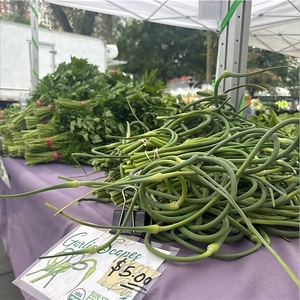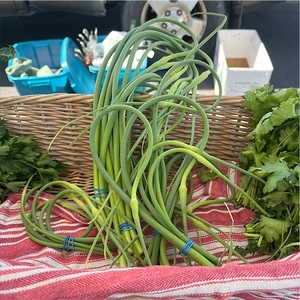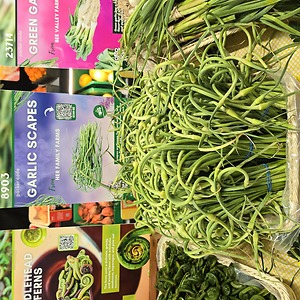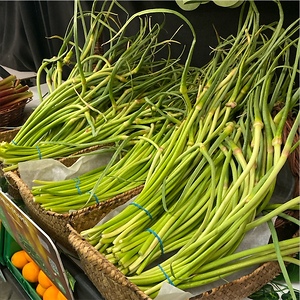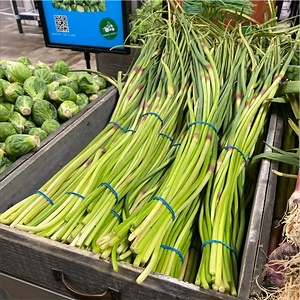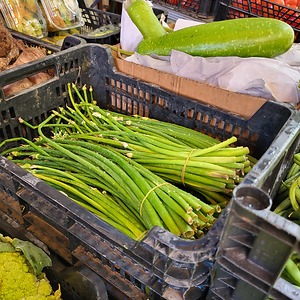


Garlic Scapes
Estimated Inventory, lb : 0
Description/Taste
Garlic scapes vary in size depending on the variety and maturity when picked but are generally harvested when they are younger. The scapes or flowering stems are long, slender, and cylindrical, with a smooth and taut appearance. Garlic scapes are pliable and transition between straight and curved, coiled shapes throughout their life cycle. As they mature, they also produce a bulb-like head at the top of the scape, commonly known as the spathe. This spathe eventually develops small flowers and bulbils, which are naturally made by the plant. Garlic scapes are typically harvested when young, pale green and the spathe is thin and small. At this stage, they are crisp and tender and have a texture reminiscent of asparagus when cooked. If harvested later, the spathes become bulbous and may split open. The scapes at this stage are fibrous, chewy, and somewhat toothsome. Garlic scapes are edible raw or cooked and release a light, green, and garlicky aroma. Scapes are known for their milder, less spicy flavor than garlic bulbs and have a fresh, grassy, subtly nutty, savory, and herbaceous taste. Once cooked, scapes develop sweeter notes, and some consumers claim that they share a flavor similar to roasted garlic bulbs.
Seasons/Availability
Garlic scapes are available in the late spring through early summer.
Current Facts
Garlic scapes, botanically classified as Allium sativum var. ophioscorodon, are young flowering stalks belonging to the Amaryllidaceae family. The stems grow directly from the plant’s underground bulb and travel toward the sky, initially curling into loops and later straightening to produce flowers and seeds. Throughout history, Garlic scapes are traditionally removed from the plants to encourage the plants to place their energy into growing larger bulbs. The edible stems have been consumed among commercial farmers and home gardeners for centuries as a springtime delicacy, and they eventually expanded into specialty products sold in farmer’s markets. It is important to note that Garlic scapes are only produced by hardneck garlic varieties. The seasonal scapes only appear for a few weeks each year and are collected from wild and cultivated plants as a fresh culinary ingredient. Worldwide, Garlic scapes are sometimes known as Garlic shoots, curls, stems, stalks, and spears. Garlic scapes are harvested when they are young, curled, and coiled and are valued for their ability to add a touch of coloring, aroma, and mild flavors to a wide array of fresh and cooked culinary preparations.
Nutritional Value
Garlic scapes are a source of fiber to regulate the digestive tract and vitamins A, B6, and C to maintain healthy organs, aid in brain development, and strengthen the immune system. Scapes also provide minerals, including phosphorus, calcium, iron, and manganese. Calcium and phosphorus support bone and teeth health, iron develops the protein hemoglobin for oxygen transport through the bloodstream, and manganese helps maintain overall bodily well-being. Beyond vitamins and minerals, Garlic scapes are believed to have antibacterial, anti-inflammatory, and antioxidant properties. They are also consumed as a natural diuretic to detox the body.
Applications
Garlic scapes have a fresh, savory, and herbaceous flavor suited for raw and cooked preparations. Young scapes are the preferred stage for culinary use to ensure they have a more tender texture and less fibrous nature. The ends of the scapes should be trimmed, and the bulbs, also known as spathes, should be removed at the top. Once prepped, Garlic scapes are thinly sliced and added as a garnish to salads, slaws, and grain bowls. They can also be mixed with herbs in creamy dips or blended into salad dressings. One of the most popular recipes is incorporating scapes into springtime pesto. They are added to compound butter, hummus, or topped over bruschetta. Garlic scapes are used similarly to chives and green onions, adding a light flavor to soups. They are also cooked to develop a mellower, sweeter taste. Try sautéing Garlic scapes with salt and serving them as a simple side dish. They are also commonly braised or grilled for a smokey flavor. Garlic scapes can be cooked and layered onto burgers or sandwiches, steamed with clams, or chopped and folded into batters for muffins and scones. The scapes’ savory taste is sometimes used as a pizza topping in Europe or cooked into egg-based dishes like scrambles, quiche, omelets, and frittatas. In Asia, Garlic scapes are a seasonal ingredient commonly served with pork or beef. The scapes are stir-fried into noodle and rice dishes or battered and fried like tempura green beans. Garlic scapes are also simmered into curries throughout India. For extended use, the scapes can be dehydrated in small pieces or dried, ground into powder, and used as a seasoning. Garlic scapes pair well with springtime vegetables like artichokes, peas, fava beans, morel mushrooms, new potatoes, and radishes, nuts including pine, almonds, and walnuts, and herbs such as basil, oregano, and parsley. Whole, unwashed Garlic scapes will last for 2 to 3 weeks when stored wrapped in a paper towel in a sealed container in the refrigerator. They can also be frozen for several months.
Ethnic/Cultural Info
Garlic scapes famously produce the plant’s flowers, which also share the bulb’s pungent aroma. Garlic flowers are notably referenced in Irish author Bram Stoker’s novel Dracula, written in 1897. In the book, Garlic flowers are prescribed by Doctor Van Helsing as a method of protection to guard the heroine, Lucy, while she sleeps. The Dutch doctor believed the flower’s pungent scent would keep Dracula away from Lucy, so he scattered Garlic flowers across the room, along the window seal, and around her bed. He also had Lucy wear a garland of flowers around her neck while she slept. Despite the doctor’s efforts, a series of events led the flowers to be unsuccessful in protecting the heroine, but the imagery of garlic as a defensive force against vampires continued throughout folklore worldwide. After the success of Stoker’s novel, many movies and TV shows were made about the book, but movie depictions began to use garlic bulbs instead of garlic flowers, shifting focus to the folkloric properties of the bulbs over the flowers.
Geography/History
Garlic is an ancient species descended from wild plants first found in Central Asia. The exact origin of garlic is unknown, but historians point to areas of the Tien Shan Mountains in Kyrgyzstan, Kazakhstan, and West China. Garlic scapes have been present for as long as the plant’s history and are a secondary, seasonal crop collected by growers as a delicacy. Garlic was spread in early times throughout Asia and North Africa and was later utilized throughout the Ancient Egyptian, Roman, and Greek Empires as a medicinal and culinary ingredient. It was also prevalent in the histories of civilizations in China and India. Garlic, as a plant species, was domesticated over time and transported along trade routes, spreading across Europe, Africa, and Asia. Garlic was used in Europe beginning in the Middle Ages and arrived in England in 1548. The species was later carried to North America in the 17th century through European settlers and was extensively grown by the early to mid-20th century. Today, Garlic scapes are seasonally grown worldwide and favored as a springtime culinary delicacy. The fleshy scapes are primarily sold through local markets as a secondary crop collected from garlic plants and are also picked by home gardeners in garlic-growing regions around the world.
Recipe Ideas
Recipes that include Garlic Scapes. One



